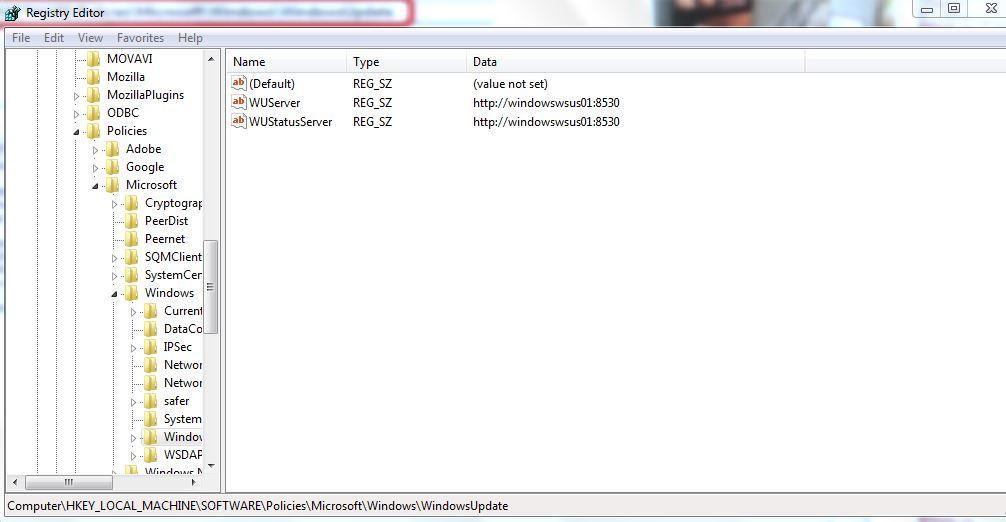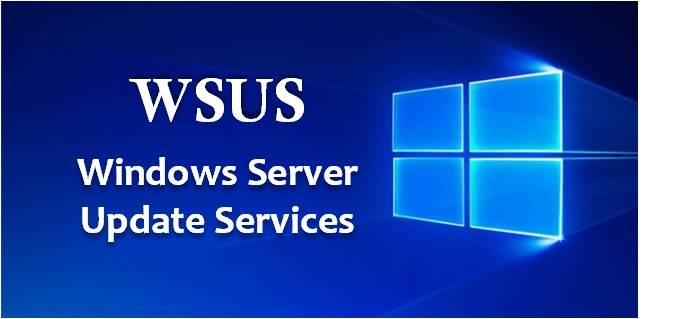WSUS registry keys settings
There are two ways to configure WSUS clients. The approach you employ is determined on whether or not your network uses Active Directory. With a non-enterprise network (one that does not use Active Directory), you would configure Automatic Updates using Control Panel, following the steps outlined in the section “Windows Automatic Updates” earlier in this chapter.
The Registry of each client would then be modified to reflect the location of the server that will give the automated updates. Automatic updates are commonly configured using Group Policy in a business network utilising Active Directory.
Group policies are used in Active Directory to control configuration and security settings. Group Policy is also used to define which server will be utilized for Automatic Updates by a client.
If Automatic Updates are enabled using Group Policy, the user will be unable to update the settings by going to Control Panel > System and clicking the Automatic Updates tab. Setting a Non-Active Directory Network Client The simplest approach to set up the client for Automatic Updates is to go to Control Panel > System and then click the Automatic Updates tab.
You may, however, configure Automatic Updates using the Registry. The Registry is a database that contains all of your server settings. To access it, go to Start > Run and type regedit in the Run dialogue box. The Automatic Updates settings are managed via
HKEY_LOCAL_MACHINE\Software\Policies\Microsoft\Windows\ WindowsUpdate\AU.
Windows Registry Editor Version 5.00
[HKEY_LOCAL_MACHINE\SOFTWARE\Policies\Microsoft\Windows\WindowsUpdate] “WUServer”=”http://windowswsus01:8530” “WUStatusServer”=”http://windowswsus01:8530” [HKEY_LOCAL_MACHINE\SOFTWARE\Policies\Microsoft\Windows\WindowsUpdate\AU] “NoAutoUpdate”=dword:00000000 “AUOptions”=dword:00000004 “ScheduledInstallDay”=dword:00000000 “ScheduledInstallTime”=dword:00000003 “UseWUServer”=dword:00000001
Configuring a Client in an Active Directory Network
If you need to figure out which server is the WSUS (Windows Server Update Services) server or you need to know if the computer you are working on is pointing to a particular WSUS server, you need to know where the WSUS registry key is. The WSUS Registry Key is:
HKEY_LOCAL_MACHINE > Software > Policies > Microsoft > Windows > WindowsUpdate

So, that’s all in this blog. I will meet you soon with next stuff. Have a nice day!!!
FAQs
Where is the registry key for WSUS?
Registry entries for the WSUS server are located in the following subkey: HKEY_LOCAL_MACHINE\Software\Policies\Microsoft\Windows\WindowsUpdate.
What is the registry key for Windows Update service?
HKEY\LOCAL\MACHINE\SOFTWARE\Policies\Microsoft\Windows\WindowsUpdate\AU configures Windows Update to automatically download and install new updates. To disable Windows Automatic Updates, set the Value data of NoAutoUpdate to 1. To enable them, set it to 0.
What is registry keys?
Registry keys are containers that act like folders, with values or subkeys contained within them. Registry values are similar to files (not containers). The relatively straightforward syntax and simple user interface keep the size of the registry low. Not all applications use the registry.
What is WSUS server and how it works?
WSUS is also known as Windows Server Update Services, and its first version is called Server Update Services (SUS). It helps distribute updates, fixes, and other types of releases available from Microsoft Update.
How do I push updates from WSUS server to clients?
In the WSUS Administration Console, go to Update Services\Server_Name\Updates\All Windows 10 Upgrades.
Right-click the feature update you want to deploy, and then select Approve.
In the Approve Updates dialog box, from the Ring 4 Broad Business Users list, select Approved for Install.
What is SCCM and WSUS?
WSUS and SCCM are two different legacy products by Microsoft that are used for IT management. They each have unique capabilities that serve endpoints and ensure they are in optimal condition. Read on to learn more about the roles of SCCM vs WSUS in an IT environment.
How do I maintain my WSUS server?
The basic steps necessary for proper WSUS maintenance include:
Back up the WSUS database.
Create custom indexes.
Reindex the WSUS database.
Decline superseded updates.
Run the WSUS Server Cleanup Wizard.
Can you use WSUS without SCCM?
Yes, we can use WSUS without SCCM.
How do I install patches on WSUS?
Install and configure WSUS.
Create and apply update groups.
Approve and deploy updates.
Monitor and report update status.
Here’s what else to consider.
What is the latest version of WSUS?
4.0 26 October 2012 Part of Windows Server 2012 and 2012 R2
5.0 26 September 2016 Part of Windows Server 2016
10.0.17763 2019 Part of Windows Server 2019
10.0.20348.1 2021 Part of Windows Server 2022
How do I select all updates in WSUS?
In the WSUS administration console, expand Updates, and then select All Updates. By default, updates are displayed with their title, classification, installed/not applicable percentage, and approval status.
What port is used for WSUS?
port 8530
By default, WSUS is configured to use HTTP (non-SSL) over port 8530, and HTTPS (SSL) over port 8531.
Is IIS required for WSUS?
Before installing WSUS, make sure you have Internet Information Services (IIS) installed. By default, WSUS uses the default Web site in IIS. WSUS Setup also gives you the option of creating a Web site on a custom port. If the IIS service (W3SVC) is stopped during WSUS installation, WSUS Setup starts the service.
What is the WSUS service called?
Windows Server Update Services (WSUS) is a Windows server role that can plan, manage and deploy updates, patches and hotfixes for Windows servers, client operating systems (OSes) and other Microsoft software.
Where is the WSUS database located?
WinDir%\WID\Data
What is the minimum RAM for WSUS?
2 GB
Can we delete WSUS content files?
Navigate to the WSUSContent folder and press Shift-Delete. This will delete the entire folder. Then open a command prompt and navigate to the Program Files\Update Services\Tools folder and execute the command “WSUSUtil reset.
Does WSUS require SSL?
WSUS also uses SSL to encrypt update metadata.
Does WSUS need a certificate?
Yes
What is the difference between WSUS and WDS?
The major difference between WSUS and WDS is that one is a windows server update services where updates are deployed to servers and workstations added to the computer group in the WSUS config.
Is Microsoft WSUS free?
Cost of WSUS
WSUS is a free tool installed as a role on Windows Server.
Can WSUS deploy 3rd party patches?
Yes.
How do I export patches from WSUS?
In the WSUS Server tab ‘Export’ under WSUS signing certificate. Click the Export button to begin.
What are the benefits of WSUS?
WSUS is an update management platform that can schedule and control updates for large numbers of machines at once, enabling useful bandwidth savings and remote management features. WSUS features also automatic update approvals, automatic device enrollment, and email notifications/reports.
Does WSUS use port 443?
WSUS uses ports 80/443 to contact Microsoft.
- Select Start, search for “regedit”, and then open Registry Editor.
- Open the following registry key: HKEY_LOCAL_MACHINE\SOFTWARE\Policies\Microsoft\Windows\WindowsUpdate\AU.
- Add one of the following registry values to configure Automatic Update. NoAutoUpdate (REG_DWORD):
Where is the registry stored?
C:\Windows\System32\config\*
WSUS is also known as Windows Server Update Services, and its first version is called Server Update Services (SUS). It helps distribute updates, fixes, and other types of releases available from Microsoft Update.
So, that’s all in this blog. I will meet you soon with next stuff. Have a nice day!!!
Guys please don’t forget to like and share the post. Also join our WindowsTechno Community and where you can post your queries/doubts and our experts will address them.
You can also share the feedback on below windows techno email id.
If you have any questions feel free to contact us on admin@windowstechno.com also follow us on facebook@windowstechno to get updates about new blog posts.

